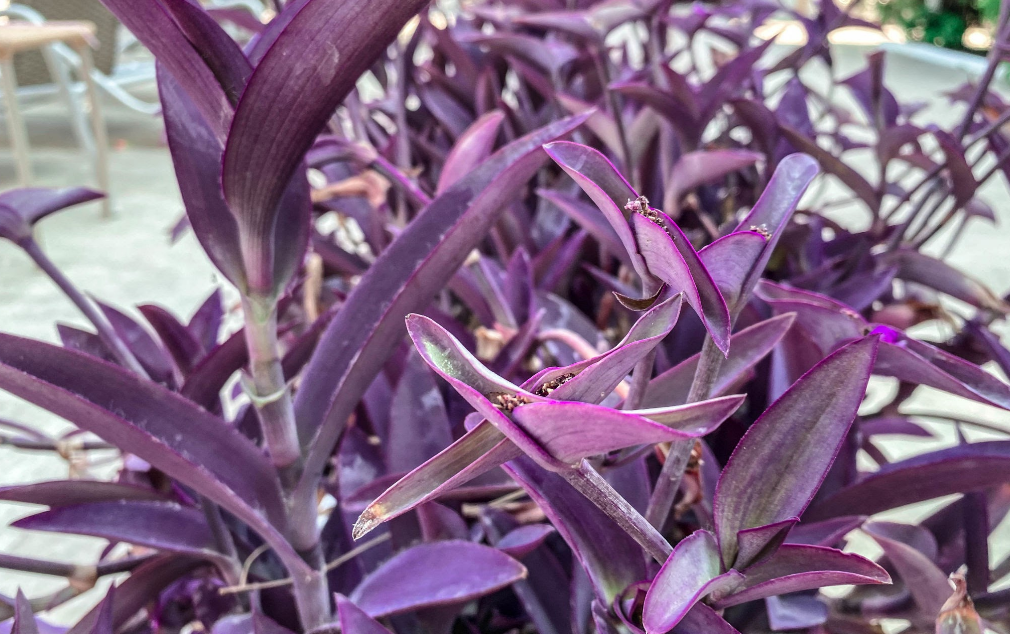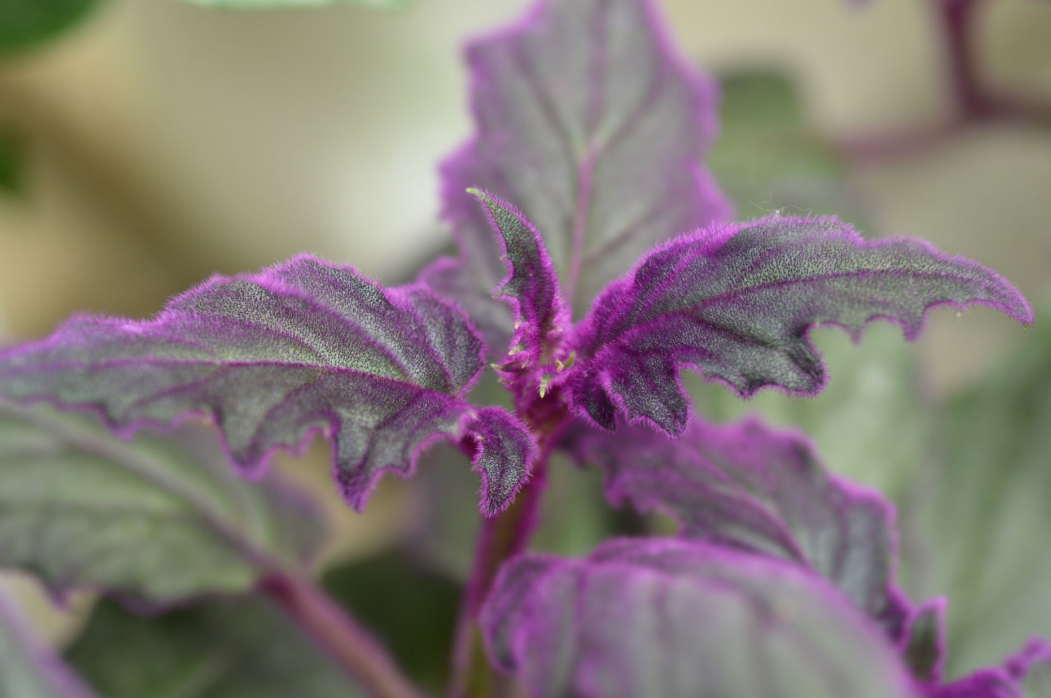The plant with purple and green leaves is one of the most beautiful things that nature has made. With its stunning foliage and intriguing features, this plant has captured the hearts of many horticulturists. What is the exact name of a plant whose leaves are both purple and green? Take your time, we’re going to look at some beautiful purple-leafed plants and learn about them.
Looking to add a splash of color to your home’s interior? Purple and green plants are a gorgeous way to incorporate vivid yet complementary hues. From deep purple leaves to variegated foliage mixing purple, green, and more, these plants provide beautiful contrasts.
In this article, we’ll highlight 15 of the best purple and green houseplants perfect for any indoor space.
Vibrant Purple Foliage
These indoor plants sport stunning purple leaves that make a bold statement, The rich jewel tones stand out against any decor
Coleus
With its ruffled spikes of purple foliage, coleus brings unique texture indoors. The leaves can range from deep purple to reddish-purple depending on sunlight levels. Coleus thrives in bright, indirect light and moist soil. The colorful leaves look fantastic in containers or hanging baskets.
Oxalis
Also called purple shamrock oxalis has dramatic dark purple nearly black leaves. The foliage folds up at night, then reopens in the morning to maximize sunlight capture. Dainty white or pink flowers add to its charm. Give oxalis partial sun and water when the soil dries out.
Prayer Plant
The prayer plant gets its name from the way its leaves fold up vertically at night. The velvety green leaves have a vivid purple underside. Place prayer plants in indirect sunlight to maintain their colorful foliage. Keep the soil consistently moist.
Purple Heart
With its slender purple leaves and stems, the purple heart plant lives up to its name. This trailing plant looks spectacular spilling over container edges or hanging baskets. Purple hearts need at least a few hours of direct sun and occasional watering.
Purple Passion
One of the most vibrant purple houseplants, purple passion boasts glossy green leaves with deep purple undersides and stems. For best color, give these plants partial sun and keep the soil moist. Its lush cascading growth makes an eye-catching display.
Subtle Purple Accents
For a more understated effect, these plants mix splashes of purple with green and other hues. Their colorful leaves add tasteful pops of color indoors.
Moses in the Cradle
Also called oyster plant, Moses in the cradle has long green leaves striped with purple. This compact plant produces small white flowers that resemble boats. For optimal color, provide bright indirect light. Water when the top inch of soil becomes dry.
Calathea
With its vivid green tops and deep purple undersides, calathea makes a living work of art indoors. These tropical plants thrive in high humidity and indirect sunlight. Water weekly to keep the soil consistently moist but not soggy.
Waffle Plant
The waffle plant gets its name from its crinkled purple-green leaves. Tiny white flowers occasionally appear but the foliage steals the show on this low-growing plant. Give waffle plants medium to bright indirect light and moist soil.
Persian Shield
Exotic-looking Persian shield has iridescent purple leaves marked with bright green veins. For the most intense leaf colors, provide bright filtered sunlight. These tropical plants need constant warmth and moisture. Mist the leaves regularly for added humidity.
Rex Begonia
Few houseplants can match a rex begonia’s dramatic foliage. The large, colorful leaves have swirls, spots, and splashes in purple, green, silver, and red. Grow rex begonias in humid rooms with partial sun and rich, porous potting mix. Avoid overwatering.
Variegated Varieties
These indoor plants mix shades of purple, green, and other colors for uniquely patterned foliage. The variegation makes them stand out.
Purple Waffle Plant
Also known as red ivy, the purple waffle plant has olive-green leaves edged in purple. The crinkled, ridged foliage resembles a waffle, hence the name. Small white flowers occasionally appear. Give these plants medium light and keep the soil moist.
Tradescantia Zebrina
Sometimes called inchplant, Tradescantia zebrina has green leaves striped with silvery purple. Dense and low-growing, these plants are perfect for containers and hanging baskets. Provide bright indirect sunlight and water when the top inch of soil becomes dry.
Ruby Necklace
The succulent Ruby Necklace trails gracefully with colorful stems of purple and green. Dangling pairs of leaves emerge from pinkish-purple stems for a colorful cascading effect. As a succulent, it thrives in bright light with occasional watering.
Graptoveria
This cute succulent has rosette-shaped leaves blending hues of purple, green, silver, and pink. Graptoverias stay compact, making them ideal for dish gardens and mixed containers. Give them at least a few hours of direct sun and let the soil dry between waterings.
Chinese Evergreen
An easy care houseplant, Chinese evergreen has broad green leaves decorated with central veins in pink, red, or purple. Solid purple leaf varieties are also available. Chinese evergreens adapt to both low and bright light with minimal watering needs.
Care Tips
Caring for purple and green indoor plants is fairly straightforward. Here are some general tips to help them thrive:
-
Provide the recommended amount of sunlight for each plant – most do best in bright indirect light. Avoid full sun, which can fade colors.
-
Use porous, well-draining potting mix and avoid letting plants sit in water. Overwatering can lead to root rot.
-
Water when the top inch or so of soil becomes dry. The exact watering frequency depends on factors like sunlight and temperature.
-
Increase humidity around purple plants by misting leaves or using a humidifier. Dry air can cause leaf browning.
-
Turn plants periodically so all sides get equal light exposure. This encourages even, colorful new growth.
-
Remove faded flowers and leggy stems through regular pruning. Pinch back tips to promote bushiness.
-
Watch for pests like aphids, mealybugs and spider mites and treat any infestations promptly.
-
Repot when plants become rootbound. Use containers with drainage holes and well-draining potting mix.
With a spectrum of purple tones complemented by green, these indoor plants can transform any space. Their colorful leaves breathe life into home decor all year long. With proper care, these eye-catching specimens will keep wowing you for years to come.
Purple Heart Plant (Tradescantia pallida)

The Purple Heart Plant is a unique and beautiful succulent-like plant that is known for its long, lance-shaped leaves that are usually a deep, rich purple color. These leaves give the plant its unique look. In addition to its foliage, it can produce small, inconspicuous pink or violet flowers.
USDA Zone: 7 to 11
Purple Velvet Plant (Gynura aurantiaca)

The Purple Velvet Plant is another houseplant with purple and green leaves. The beautiful thing about it is its thick, velvety leaves that are a bright purple color on the underside, making them look like rich velvet. Furthermore, the leaves are soft to the touch, further enhancing their velvety appearance.
If the conditions are right, it can produce small, bright orange flowers, but its leaves are what people really want to see.
USDA Zone: 6 to 9
6 Best Purple Vines You Can Grow as Houseplants
Which purple houseplants can you keep at home?
Here are a few of our favorite purple houseplants that you can keep at home: The purple passion plant (Gynura aurantiaca) is as exotic as it is beautiful. The distinctive leaves are velvet to the touch and outlined in bright purple. The purple passion is an annual plant, meaning that it is not possible to keep the same plant alive for years.
Are purple indoor plants a good color?
Purple indoor plants are a great way to enjoy color in your home when outdoor gardening is out of season (we’re looking at you, winter). With this shade, there are so many hues to choose from to have in your plant buddies from the faintest of purples to the boldest and most vibrant.
What colors do purple houseplants grow?
These purple houseplants feature a variety of lush leaves that grow in shades of green and purple and blossoms that bloom in various colors and variegations, including several in different shades of purple. You’ll never want to stop once you get the hang of growing African violets. Prefers constant, even moisture soil but never soggy soil.
Why should you choose purple houseplants?
Purple Houseplants add life, light, and warmth to interior design. If you’re looking to elevate the visual interest of your indoor plant collection, why not shift from pure green to purple houseplants?
- The Ultimate Guide to Growing Strawberries in Raised Beds - August 8, 2025
- No-Dig Garden Beds: The Easiest Way to Grow a Beautiful Garden - August 6, 2025
- How to Protect and Preserve Wood for Raised Garden Beds - August 6, 2025

